Abstract
To investigate the duration and kinetics of immunoglobulin M (IgM) and IgG antibodies against Borrelia burgdorferi in serum after treatment of Lyme borreliosis, consecutive serum samples from 30 seropositive patients with erythema migrans and 91 seropositive patients with neuroborreliosis were analyzed with a capture IgM enzyme-linked immunosorbent assay (ELISA) and an indirect IgG ELISA, both using B. burgdorferi flagella as the antigen. All the patients improved after treatment: 97 patients had a complete clinical recovery, while 24 patients had sequelae. The results showed that patients with erythema migrans and early neuroborreliosis more often initially had highly elevated IgM optical density (OD) values and low IgG OD values against B. burgdorferi, while the opposite was found in patients with late neuroborreliosis. During follow-up, the majority of patients had developed negative or significantly declining IgM ODs after 1 to 1.5 years but persistently positive IgM ODs were found up to 17 months after treatment of erythema migrans and 3 years after treatment of neuroborreliosis. IgG antibody levels declined more slowly and remained elevated to a larger extent, but more than half of the patients had developed negative IgG ODs within 5 years after therapy. However, positive IgG OD values were found after 9 to 10 years for patients treated for neuroborreliosis as well as erythema migrans. Both IgM and IgG antibodies against B. burgdorferi may persist for months to years after successful treatment of Lyme borreliosis. Consequently, a single serum sample with antibodies against B. burgdorferi must always be carefully evaluated and correlated to clinical symptoms.
Full text
PDF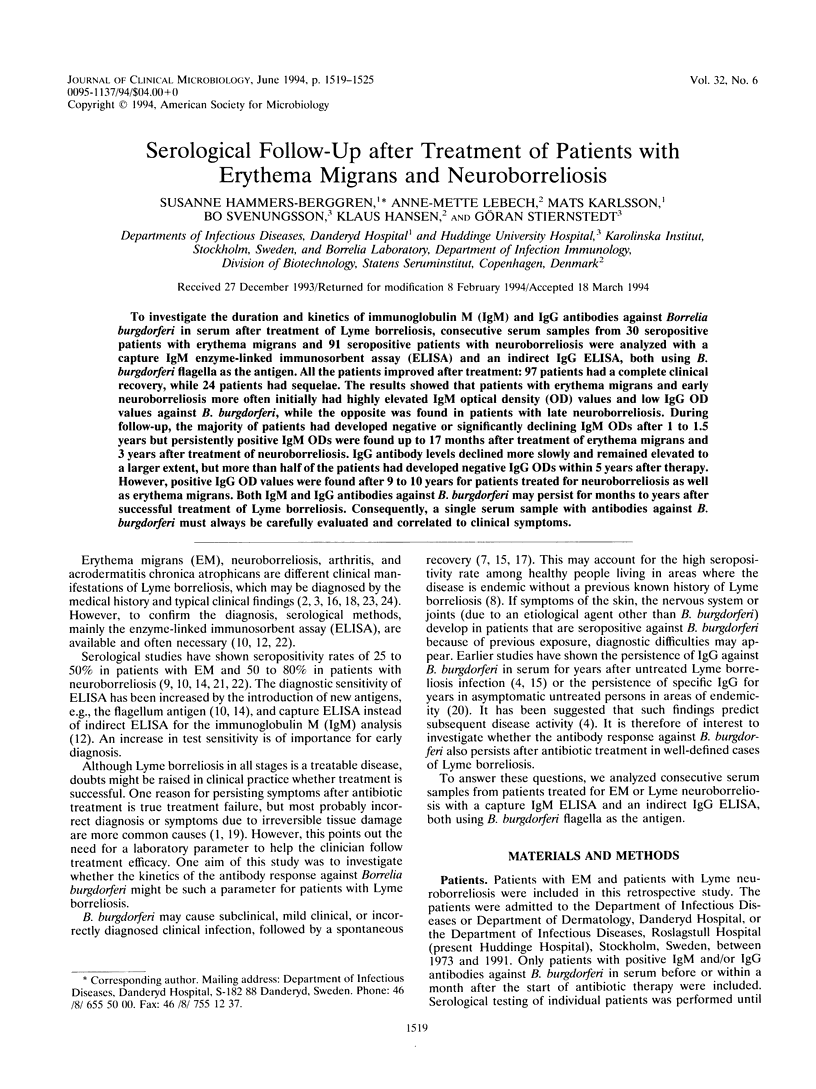
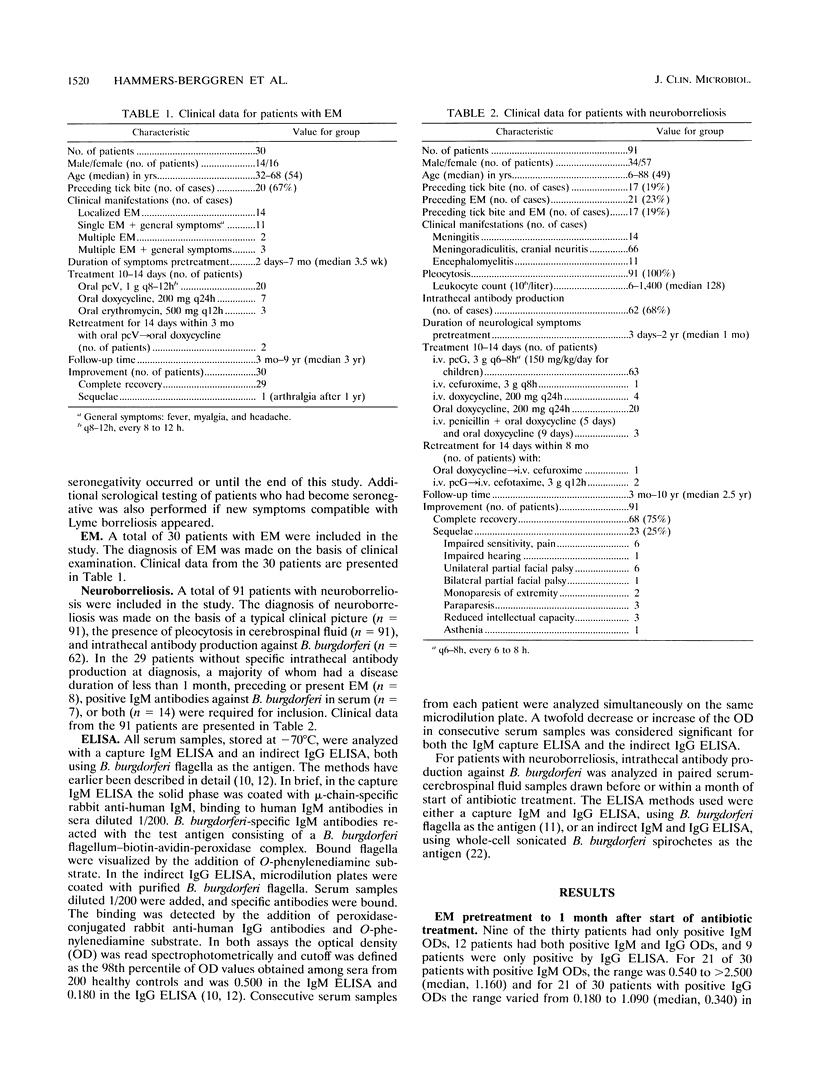
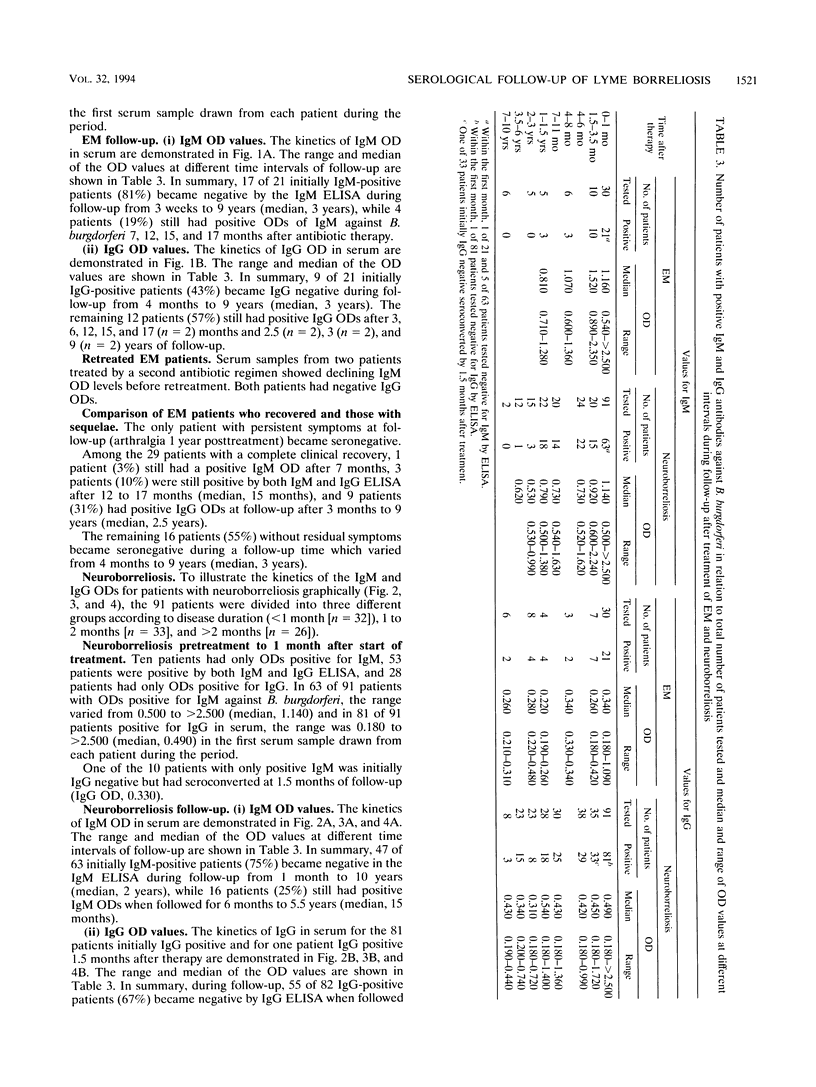
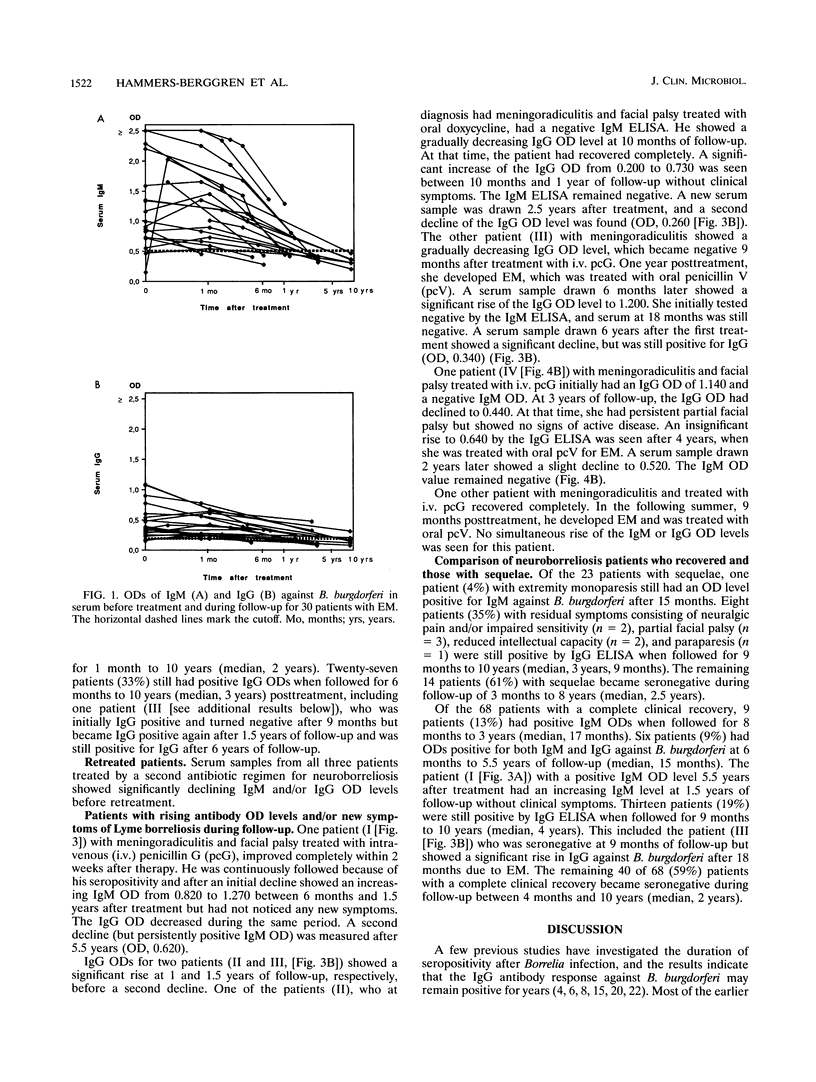
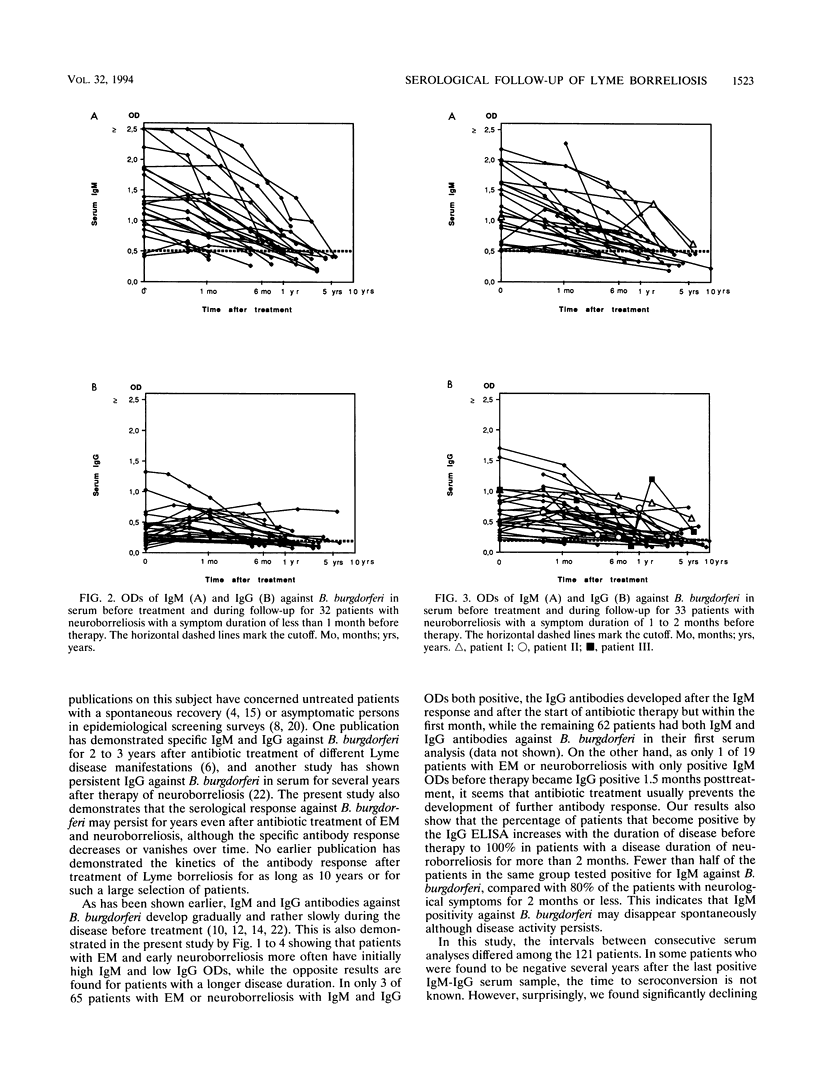
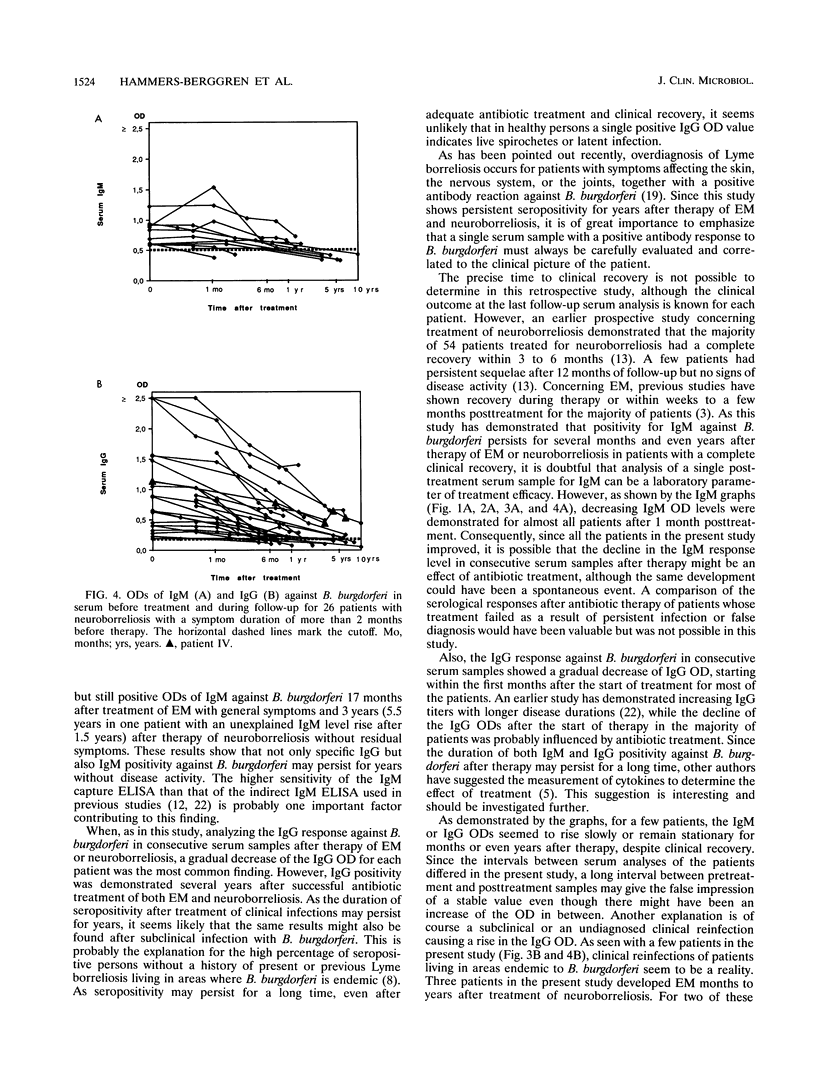
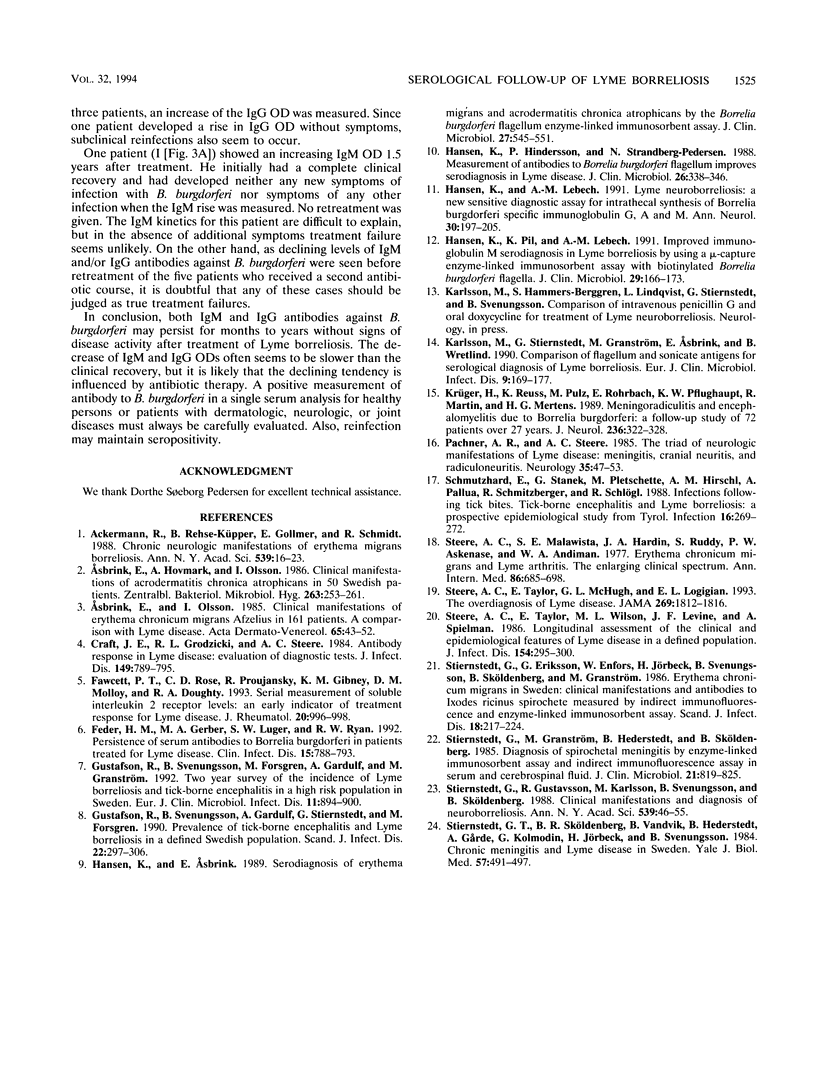
Selected References
These references are in PubMed. This may not be the complete list of references from this article.
- Ackermann R., Rehse-Küpper B., Gollmer E., Schmidt R. Chronic neurologic manifestations of erythema migrans borreliosis. Ann N Y Acad Sci. 1988;539:16–23. doi: 10.1111/j.1749-6632.1988.tb31834.x. [DOI] [PubMed] [Google Scholar]
- Asbrink E., Hovmark A., Olsson I. Clinical manifestations of acrodermatitis chronica atrophicans in 50 Swedish patients. Zentralbl Bakteriol Mikrobiol Hyg A. 1986 Dec;263(1-2):253–261. doi: 10.1016/s0176-6724(86)80128-6. [DOI] [PubMed] [Google Scholar]
- Asbrink E., Olsson I. Clinical manifestations of erythema chronicum migrans Afzelius in 161 patients. A comparison with Lyme disease. Acta Derm Venereol. 1985;65(1):43–52. [PubMed] [Google Scholar]
- Craft J. E., Grodzicki R. L., Steere A. C. Antibody response in Lyme disease: evaluation of diagnostic tests. J Infect Dis. 1984 May;149(5):789–795. doi: 10.1093/infdis/149.5.789. [DOI] [PubMed] [Google Scholar]
- Fawcett P. T., Rose C. D., Proujansky R., Gibney K. M., Molloy D. M., Doughty R. A. Serial measurement of soluble interleukin 2 receptor levels: an early indicator of treatment response for Lyme disease. J Rheumatol. 1993 Jun;20(6):996–998. [PubMed] [Google Scholar]
- Feder H. M., Jr, Gerber M. A., Luger S. W., Ryan R. W. Persistence of serum antibodies to Borrelia burgdorferi in patients treated for Lyme disease. Clin Infect Dis. 1992 Nov;15(5):788–793. doi: 10.1093/clind/15.5.788. [DOI] [PubMed] [Google Scholar]
- Gustafson R., Svenungsson B., Forsgren M., Gardulf A., Granström M. Two-year survey of the incidence of Lyme borreliosis and tick-borne encephalitis in a high-risk population in Sweden. Eur J Clin Microbiol Infect Dis. 1992 Oct;11(10):894–900. doi: 10.1007/BF01962369. [DOI] [PubMed] [Google Scholar]
- Gustafson R., Svenungsson B., Gardulf A., Stiernstedt G., Forsgren M. Prevalence of tick-borne encephalitis and Lyme borreliosis in a defined Swedish population. Scand J Infect Dis. 1990;22(3):297–306. doi: 10.3109/00365549009027051. [DOI] [PubMed] [Google Scholar]
- Hansen K., Asbrink E. Serodiagnosis of erythema migrans and acrodermatitis chronica atrophicans by the Borrelia burgdorferi flagellum enzyme-linked immunosorbent assay. J Clin Microbiol. 1989 Mar;27(3):545–551. doi: 10.1128/jcm.27.3.545-551.1989. [DOI] [PMC free article] [PubMed] [Google Scholar]
- Hansen K., Hindersson P., Pedersen N. S. Measurement of antibodies to the Borrelia burgdorferi flagellum improves serodiagnosis in Lyme disease. J Clin Microbiol. 1988 Feb;26(2):338–346. doi: 10.1128/jcm.26.2.338-346.1988. [DOI] [PMC free article] [PubMed] [Google Scholar]
- Hansen K., Lebech A. M. Lyme neuroborreliosis: a new sensitive diagnostic assay for intrathecal synthesis of Borrelia burgdorferi--specific immunoglobulin G, A, and M. Ann Neurol. 1991 Aug;30(2):197–205. doi: 10.1002/ana.410300212. [DOI] [PubMed] [Google Scholar]
- Hansen K., Pii K., Lebech A. M. Improved immunoglobulin M serodiagnosis in Lyme borreliosis by using a mu-capture enzyme-linked immunosorbent assay with biotinylated Borrelia burgdorferi flagella. J Clin Microbiol. 1991 Jan;29(1):166–173. doi: 10.1128/jcm.29.1.166-173.1991. [DOI] [PMC free article] [PubMed] [Google Scholar]
- Karlsson M., Stiernstedt G., Granström M., Asbrink E., Wretlind B. Comparison of flagellum and sonicate antigens for serological diagnosis of Lyme borreliosis. Eur J Clin Microbiol Infect Dis. 1990 Mar;9(3):169–177. doi: 10.1007/BF01963833. [DOI] [PubMed] [Google Scholar]
- Krüger H., Reuss K., Pulz M., Rohrbach E., Pflughaupt K. W., Martin R., Mertens H. G. Meningoradiculitis and encephalomyelitis due to Borrelia burgdorferi: a follow-up study of 72 patients over 27 years. J Neurol. 1989 Sep;236(6):322–328. doi: 10.1007/BF00314373. [DOI] [PubMed] [Google Scholar]
- Pachner A. R., Steere A. C. The triad of neurologic manifestations of Lyme disease: meningitis, cranial neuritis, and radiculoneuritis. Neurology. 1985 Jan;35(1):47–53. doi: 10.1212/wnl.35.1.47. [DOI] [PubMed] [Google Scholar]
- Schmutzhard E., Stanek G., Pletschette M., Hirschl A. M., Pallua A., Schmitzberger R., Schlögl R. Infections following tickbites. Tick-borne encephalitis and Lyme borreliosis--a prospective epidemiological study from Tyrol. Infection. 1988 Sep-Oct;16(5):269–272. doi: 10.1007/BF01645068. [DOI] [PubMed] [Google Scholar]
- Steere A. C., Malawista S. E., Hardin J. A., Ruddy S., Askenase W., Andiman W. A. Erythema chronicum migrans and Lyme arthritis. The enlarging clinical spectrum. Ann Intern Med. 1977 Jun;86(6):685–698. doi: 10.7326/0003-4819-86-6-685. [DOI] [PubMed] [Google Scholar]
- Steere A. C., Taylor E., McHugh G. L., Logigian E. L. The overdiagnosis of Lyme disease. JAMA. 1993 Apr 14;269(14):1812–1816. [PubMed] [Google Scholar]
- Steere A. C., Taylor E., Wilson M. L., Levine J. F., Spielman A. Longitudinal assessment of the clinical and epidemiological features of Lyme disease in a defined population. J Infect Dis. 1986 Aug;154(2):295–300. doi: 10.1093/infdis/154.2.295. [DOI] [PubMed] [Google Scholar]
- Stiernstedt G. T., Granström M., Hederstedt B., Sköldenberg B. Diagnosis of spirochetal meningitis by enzyme-linked immunosorbent assay and indirect immunofluorescence assay in serum and cerebrospinal fluid. J Clin Microbiol. 1985 May;21(5):819–825. doi: 10.1128/jcm.21.5.819-825.1985. [DOI] [PMC free article] [PubMed] [Google Scholar]
- Stiernstedt G. T., Sköldenberg B. R., Vandvik B., Hederstedt B., Gårde A., Kolmodin G., Jörbäck H., Svenungsson B. Chronic meningitis and Lyme disease in Sweden. Yale J Biol Med. 1984 Jul-Aug;57(4):491–497. [PMC free article] [PubMed] [Google Scholar]
- Stiernstedt G., Eriksson G., Enfors W., Jörbeck H., Svenungsson B., Sköldenberg B., Granström M. Erythema chronicum migrans in Sweden: clinical manifestations and antibodies to Ixodes ricinus spirochete measured by indirect immunofluorescence and enzyme-linked immunosorbent assay. Scand J Infect Dis. 1986;18(3):217–224. doi: 10.3109/00365548609032330. [DOI] [PubMed] [Google Scholar]
- Stiernstedt G., Gustafsson R., Karlsson M., Svenungsson B., Sköldenberg B. Clinical manifestations and diagnosis of neuroborreliosis. Ann N Y Acad Sci. 1988;539:46–55. doi: 10.1111/j.1749-6632.1988.tb31837.x. [DOI] [PubMed] [Google Scholar]


